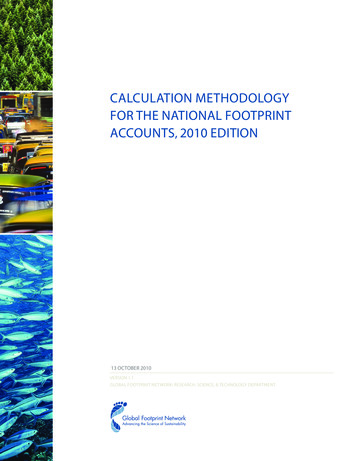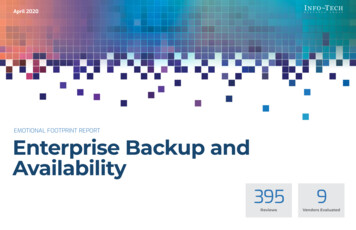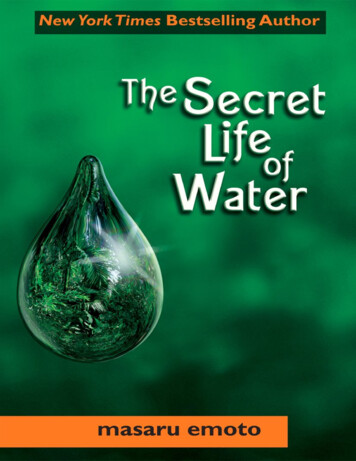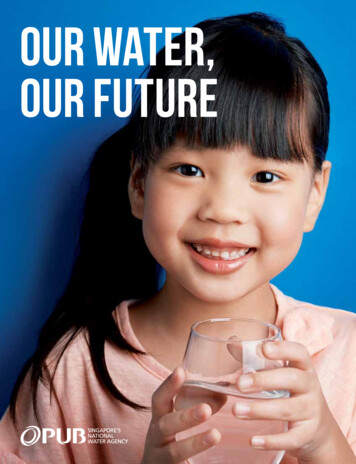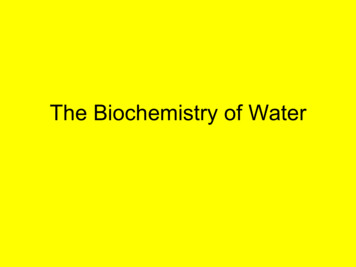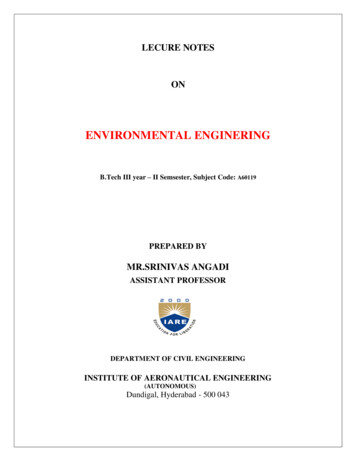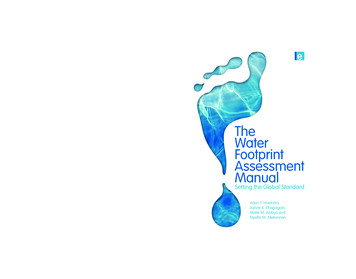
Transcription
The Water Footprint Assessment ManualHardback PPC: Live area – 159 x 240mm – Trim size – 156 x 234mm – Bleed – 18mm – Spine – 24.2mmC-M-Y-K 1 page documentThis book offers a complete and up-to-date overview of the global standardon water footprint assessment as developed by the Water Footprint Network.More specifically it:provides a comprehensive set of methods for water footprint assessmentshows how water footprints can be calculated for individual processesand products, as well as for consumers, nations and businessescontains detailed worked examples of how to calculate green, blue andgrey water footprintsdescribes how to assess the sustainability of the aggregated waterfootprint within a river basin or the water footprint of a specific productincludes an extensive library of possible measures that can contribute towater footprint reduction.Ashok K. Chapagain was an irrigation engineer in Nepal for more than a decade, hasworked as a researcher at the University of Twente and currently works for the WWF in the UK.Maite M. Aldaya works as a consultant for the United Nations Environment Programme(UNEP) and is a researcher at the Water Footprint Network.Mesfin M. Mekonnen was an energy expert at the Ministry of Mines and Energy in Ethiopia,and is currently a PhD student at the University of Twente.Water / Environmental and Sustainability Assessment /Agriculture and Foodwww.earthscan.co.ukEarthscan strives to minimize its impact on the environmentCover image: ‘Water Background’ istockphoto.com/Selahattin BAYRAMHoekstra, Chapagain, Aldaya and MekonnenArjen Y. Hoekstra is Professor in Water Management at the University of Twente, theNetherlands; creator of the water footprint concept and Scientific Director of the WaterFootprint Network.The Water Footprint Assessment ManualPeople use a lot of water for drinking, cooking and washing, butsignificantly more for producing things such as food, paper and cottonclothes. The water footprint is an indicator of water use that looks at bothdirect and indirect water use of a consumer or producer. Indirect use refersto the ‘virtual water’ embedded in tradable goods and commodities, suchas cereals, sugar or cotton. The water footprint of an individual, communityor business is defined as the total volume of fresh water that is used toproduce the goods and services consumed by the individual or communityor produced by the business.TheWaterFootprintAssessmentManualSetting the Global StandardArjen Y. Hoekstra,Ashok K. Chapagain,Maite M. Aldaya andMesfin M. Mekonnen
The Water Footprint Assessment Manual
The Water Footprint Assessment ManualSetting the Global StandardArjen Y. Hoekstra, Ashok K. Chapagain,Maite M. Aldaya and Mesfin M. Mekonnenpublishing for a sustainable futureLondon Washington, DC
First published in 2011 by EarthscanCopyright Water Footprint Network 2011All rights reserved. No part of this publication may be reproduced, stored in a retrieval system, ortransmitted, in any form or by any means, electronic, mechanical, photocopying, recording or otherwise,except as expressly permitted by law, without the prior, written permission of the publisher.Earthscan Ltd, Dunstan House, 14a St Cross Street, London EC1N 8XA, UKEarthscan LLC,1616 P Street, NW, Washington, DC 20036, USAEarthscan publishes in association with the International Institute for Environment and DevelopmentFor more information on Earthscan publications, see www.earthscan.co.uk or write toearthinfo@earthscan.co.ukISBN: 978-1-84971-279-8 hardbackTypeset by JS Typesetting Ltd, Porthcawl, Mid GlamorganCover design by Rob Watts; water footprint design by Angela MorelliA catalogue record for this book is available from the British LibraryLibrary of Congress Cataloging-in-Publication DataThe water footprint assessment manual : setting the global standard / Arjen Y. Hoekstra . [et al.].p. cm.Includes bibliographical references and index.ISBN 978-1-84971-279-8 (hardback)1. Water consumption–Measurement. 2. Water consumption–Environmental aspects. 3. Watersupply–Accounting. I. Hoekstra, Arjen Y., 1967–TD499.W384 2011333.91’13–dc222010047901At Earthscan we strive to minimize our environmental impacts and carbon footprint through reducingwaste, recycling and offsetting our CO2 emissions, including those created through publication of thisbook. For more details of our environmental policy, see www.earthscan.co.uk.Printed and bound in the UK by TJ International Ltd, Padstow, Cornwall.The paper used is FSC certified and the ink are vegetable based.
ContentsList of Figures, Tables and BoxesAcknowledgementsPrefaceAcronyms1 Introduction1.1 Background1.2 The water footprint concept1.3 Water footprint assessment1.4 Guide for the readerixxiiixviixix112352 Goals and Scope of Water Footprint Assessment2.1 Goals of water footprint assessment2.2 Scope of water footprint accounting2.3 Scope of water footprint sustainability assessment2.4 Scope of water footprint response formulation77915163 Water Footprint Accounting3.1 Human appropriation of fresh water: What do we measureand why?3.2 Coherence between different sorts of water footprint accounts3.3 Water footprint of a process step3.3.1 Blue water footprint3.3.2 Green water footprint3.3.3 Grey water footprint3.3.4 Calculation of the green, blue and grey water footprintof growing a crop or tree3.4 Water footprint of a product3.4.1 Definition3.4.2 Schematization of the production system into process steps3.4.3 Calculation of a product water footprint3.5 Water footprint of a consumer or group of consumers19192123232930404646474852
viThe Water Footprint Assessment Manual3.63.73.83.93.103.5.1 Definition3.5.2 CalculationWater footprint within a geographically delineated area3.6.1 Definition3.6.2 CalculationNational water footprint accounting3.7.1 The national water footprint accounting scheme3.7.2 Calculation of the water footprint within a nation3.7.3 Calculation of the water footprint of national consumption3.7.4 Water savings related to trade3.7.5 National water dependency versus water self-sufficiencyWater footprint accounting for catchments and river basinsWater footprint accounting for municipalities, provinces or otheradministrative unitsWater footprint of a business3.10.1 Definition3.10.2 Choosing the organizational boundaries of the business3.10.3 Calculation of the business water footprint4 Water Footprint Sustainability Assessment4.1 Introduction4.2 Geographic sustainability: Sustainability of the water footprintwithin a catchment or river basin4.2.1 Introduction4.2.2 Environmental sustainability criteria for identifyingenvironmental hotspots4.2.3 Social sustainability criteria for identifying social hotspots4.2.4 Economic sustainability criteria for identifying economichotspots4.2.5 Assessing primary and secondary impacts in the hotspotsidentified4.3 Sustainability of the water footprint of a process4.4 Sustainability of the water footprint of a product4.4.1 Identifying the unsustainable components in the waterfootprint of a product4.4.2 Water footprint impact indices reflecting localenvironmental impacts4.5 Sustainability of the water footprint of a business4.6 Sustainability of the water footprint of a 78878888899191949797
Contents vii5 Library of Water Footprint Response Options5.1 Shared responsibility5.2 Reducing the water footprint of humanity: What is possible?5.3 Consumers5.4 Companies5.5 Farmers5.6 Investors5.7 Governments9999991031061071091106 Limitations1157 Future Challenges7.1 Water footprint assessment methodology and data7.2 Application of the water footprint in different contexts7.3 Embedding the water footprint in existing water andenvironmental accounts and reports7.4 Linking to ecological, energy and carbon footprint methods7.5 Linking to material flow analysis, input-output modelling and lifecycle assessment1191191228 Conclusion129Appendix IAppendix IIAppendix IIIAppendix IVAppendix VAppendix VICalculation of Green and Blue Evapotranspiration Using theCROPWAT ModelCalculating the Process Water Footprint of Growing a Crop:An Example for Sugar Beet in Valladolid (Spain)Calculating the Water Footprint of a Product: Example forRefined Sugar from Valladolid (Spain)Examples of Grey Water Footprint CalculationsEnvironmental Flow RequirementsFrequently Asked QuestionsReferencesList of 183187199
List of Figures, Tables and BoxesFigures1.1 Schematic representation of the components of a water footprint.It shows that the non-consumptive part of water withdrawals(the return flow) is not part of the water footprint. It also shows that,contrary to the measure of ‘water withdrawal’, the ‘water footprint’includes green and grey water and the indirect water-use component31.2 Four distinct phases in water footprint assessment43.1 The green and blue water footprint in relation to the water balanceof a catchment area203.2 Process water footprints as the basic building block for all other waterfootprints223.3 The direct and indirect water footprint in each stage of the supplychain of an animal product243.4 The relation between the water footprint of national consumptionand the water footprint within a nation in a simplified example fortwo trading nations243.5 Blue water footprint accounting in the case of water recycling andreuse283.6 The subsequent processes in irrigation: storing water, transport ofwater, irrigation on the field. Each process step has its own waterfootprint433.7 Schematization of the production system to produce product p intok process steps. Some steps are in series, others are parallel. The waterfootprint of output product p is calculated as the sum of the processwater footprints of the processes that constitute the production system.Note: this simplified scheme presupposes that p is the only outputproduct following from the production system483.8 Schematization of the last process step in the production system toproduce product p. The water footprint of output product p iscalculated based on the water footprints of the input products and theprocess water footprint when processing the inputs into the outputs 49
xThe Water Footprint Assessment Manual3.93.103.113.124.14.2II.1III.1The national water footprint accounting scheme. The accountingscheme shows the various balances that hold for the water footprintrelated to national consumption (WFcons,nat), the water footprintwithin the area of the nation (WFarea,nat), the total virtual-waterexport (Ve) and the total virtual-water import (Vi)56The catchment water footprint accounting scheme. The accountingscheme shows the various balances that hold for the water footprintof consumers living within the catchment, the water footprintwithin the catchment area, the total virtual-water export from thecatchment and the total virtual-water import into the catchment62Composition of the water footprint of a business64Business that consists of three business units producing productsA–C. Product inflow Iu[x,i] refers to the annual volume of inputproduct i from source x into business unit u. Product outflow Pu[p]refers to the annual volume of output product p from business unitu. Product flow P*u[p] refers to the part of Pu[p] that goes to anotherbusiness unit within the same business68Assessment of the sustainability of the water footprint within acatchment or river basin in four steps76The blue water footprint over a year compared to the blue wateravailability, where the latter is equal to run-off (under undevelopedconditions) minus environmental flow requirements83Climate station in Valladolid (Spain) (dot in black) and sugar beetharvested area in Spain (unit: proportion of grid cell area)136Spanish refined sugar production (from sugar beet) diagramincluding product fractions144Tables2.13.14.1Spatiotemporal explication in water footprint accounting12Examples of the components of a business water footprint64Example of how to assess the extent to which the water footprintof a product is sustainable, based on two criteria: geographicsustainability of the water footprints in the catchments in which theprocess steps are located and sustainability of the underlying processsteps themselves. Priority components in the water footprint of aproduct can be identified based on which components areunsustainable and the share of a component in the total waterfootprint of the product. The table needs to be filled separately forthe green, blue and grey water footprint of the product93
List of Figures, Tables and Boxes xi5.1Possible water footprint reduction targets per sector and waterfootprint component5.2 Priorities in water footprint reduction5.3 Corporate water footprint response options5.4 Options for crop farmers to reduce their water footprint5.5 Options for governments to reduce water footprints and mitigaterelated impacts7.1 An overview of water footprint studies7.2 How water footprint assessments can feed LCAII.1 Planting and harvesting dates and yield for sugar beet productionin Valladolid (Spain)II.2 Total green-blue water evapotranspiration based on the CWRoutput table of CROPWAT 8.0II.3 Irrigation schedule under the rain-fed scenario: Output table ofCROPWAT 8.0II.4 Irrigation schedule under the irrigation scenario: Output table ofCROPWAT 8.0II.5 Calculation of the green and blue components of the process waterfootprint (m3/ton) for sugar beet in Valladolid (Spain) using theCWR-option and irrigation schedule option for a medium soilII.6 Calculation of the grey component of the process water footprint(m3/ton) for sugar beet in Valladolid (Spain)III.1 Green, blue and grey water footprint for sugar beet in Valladolid(Spain) Boxes2.12.23.13.23.33.43.53.63.73.8Goals of water footprint assessmentAre there ‘scopes’ in water footprint accounting as there are in thecase of corporate carbon footprint accounting?The relation between the different sorts of water footprintsUnit of a water footprintData sources for the calculation of a blue water footprintThe history of the grey water footprint conceptThe concept of critical loadThe grey water footprint in different cases of point-source pollutionThree-tier approach in estimating diffuse pollution loadsData sources for the calculation of the water footprint of ‘growinga crop’8142325273134363844
xii3.9The Water Footprint Assessment ManualTerminology: Water footprint, virtual-water content, embeddedwater463.10 What is new for companies when considering their business waterfootprint?664.1 History of water footprint sustainability assessment744.2 Sustainability criteria for water use and allocation within acatchment or river basin774.3 Environmental green water requirement814.4 The effect of the green water footprint on blue water availability824.5 The sustainability of a blue water footprint depends on how itaffects both blue-water flows and stocks844.6 How the ‘blue water scarcity’ as defined in water footprint studiesdiffers from conventional water scarcity indicators865.1 Water neutrality1045.2 Water footprint offsetting105
AcknowledgementsThis manual has been written with the great help of many organizations andindividuals. First of all we would like to thank all partners of the Water FootprintNetwork that have contributed in so many different ways to the maturing of thewater footprint concept. We thank the following 130 organizations, all partners ofthe network (as per 16 October 2010): ADAS (UK), Adecagua (Spain), AllenareConsultores (Mexico), Alliance for Water Stewardship (US/Australia), AmBev– Companhia de Bebidas das Americas (Brazil), APESA (France), Arup (UK),Association du Flocon à la Vague (France), ATA – Ativos Técnicos e Ambientais(Brazil), Austrian Institute of Technology (Austria), Barilla (Italy), BeijingForestry University (China), Bianconi Consulting (UK), Bionova (Finland),Blonk Milieu Advies (Netherlands), C&A (Germany), CEIGRAM – ResearchCentre for the Management of Agricultural and Environmental Risks, TechnicalUniversity of Madrid (Spain), CESTRAS – Centro de Estudos e Estratégias paraa Sustentabilidade (Portugal), Climate Change Commission (Philippines), CocaCola Hellenic (Greece), Confederation of European Paper Industries (Belgium),Consejo Consultivo del Agua (Mexico), Conservation International (US),CREM (Netherlands), CSE Centre for Sustainability and Excellence (Greece),CSQA Certificazioni (Italy), Cyprus University of Technology (Cyprus), DecideSoluciones Estratégicas (Mexico), Denkstatt (Austria), DHV (Netherlands),Directorate-General for Water Affairs (Netherlands), Dole Food Company(US), Eawag – Swiss Federal Institute of Aquatic Science and Technology(Switzerland), Ecolife (Belgium), Ecologic – Institute for International andEuropean Environmental Policy (Germany), Ecological Society for EasternAfrica (Kenya), Ecometrica (UK), EcosSistemas Sustainable Solutions (Brazil),EMWIS – Euro-Mediterranean Information System on know-how in theWater sector (France), Enzen Water (UK), EPAL – Empresa Portuguesa deAguas Livres (Portugal), Fibria Celulose (Brazil), First Climate (Germany),FloraHolland (Netherlands), Food and Drink Federation (UK), FundaciónCentro de las Nuevas Tecnologías del Agua (CENTA) (Spain), FundaciónChile (Chile), Geoklock – Consultoria e engenharia ambiental (Brazil), GlobalFootprint Network (US), GRACE (US), Green Solutions (Chile), Grontmij(Netherlands), Heineken (Netherlands), iMdea Water Foundation (Spain),
xivThe Water Footprint Assessment ManualInstitut für Nachhaltige Landbewirtschaftung (Germany), InternationalFinance Corporation (US), International Water Management Institute (SriLanka), Jain Irrigation Systems (India), Jutexpo (UK), Kingston University(UK), KWR – Watercycle Research Institute (Netherlands), Lafarge (France),Leibniz Institute for Agricultural Engineering Potsdam-Bornim (Germany),LimnoTech (US), Live Earth (US), Marcelino Botín Foundation – The WaterObservatory (Spain), Massey University – Soil and Earth Sciences Group (NewZealand), McCain Alimentaire (France), Michigan Technological University– Center for Water and Society (US), National Ground Water Association(US), National University of Cordoba (Argentina), Natura Cosméticos (Brazil),Nestlé (Switzerland), Netherlands Water Partnership (Netherlands), Next PlanetASBL (Belgium), Oranjewoud (Netherlands), Pacific Institute for Studies inDevelopment, Environment, and Security (US), Partners for Innovation(Netherlands), PE International (Germany), People 4 Earth (Netherlands),PepsiCo (USA), Plant and Food Research (New Zealand), PRé Consultants(Netherlands), PricewaterhouseCoopers, Province of Overijssel (Netherlands),PTS – Papiertechnische Stiftung (Germany), Pyramid Sustainable ResourceDevelopers (Australia), Quantis (Switzerland), Química del Campo (Chile),Raisio (Finland), Redevco (Netherlands), Renault (France), RodaxAgro(Greece), Royal Haskoning (Netherlands), SABMiller (UK), Safe DrinkingWater Foundation (Canada), SERI – Sustainable Europe Research Institute(Austria), Smart Approved WaterMark (Australia), Soil & More International(Netherlands), Source 44 (US), Stora Enso (Sweden), Summa EnvironmentalTechnologies (Ecuador), Swiss Development Agency (Switzerland), The CocaCola Company (US), The Nature Conservancy (US), Tobco (Belgium), UNEP(France), UNESCO-IHE Institute for Water Education (Netherlands), Unilever(UK), University of Chile (Chile), University of Natural Resources and AppliedLife Sciences (Austria), University of São Paulo – Escola de Engenharia deSão Carlos (Brazil), University of São Paulo – GovÁgua (Brazil), University ofSiena (Italy), University of Tokyo (Japan), University of Twente (Netherlands),University of Zaragoza (Spain), UPM-Kymmene Corporation (Finland),URS Corporation (UK), USAID – United States Agency for InternationalDevelopment (US), Vewin – the Dutch Association of Drinking WaterCompanies (Netherlands), Viña Concha y Toro (Chile), Viña De Martino(Chile), Viña Errazuriz (Chile), Water Neutral Foundation (South Africa), WaterStrategies (UK), Wildlife Trust (US), World Business Council for SustainableDevelopment (Switzerland), WWF – the global conservation organization(Switzerland) and Zero Emissions Technologies (Spain).We thank the members of WFN’s grey water footprint working group,which critically reviewed the grey water footprint concept and provided valuablesuggestions for improving the definition and guidelines: Jose Albiac (CITA,
Acknowledgements xvSpain), Maite Aldaya (University of Twente, the Netherlands), Brent Clothier(Plant and Food Research, New Zealand), James Dabrowski (CSIRO, SouthAfrica), Liese Dallbauman (Pepsi, UK), Axel Dourojeanni (Fundación Chile,Chile), Piet Filet (WWF, Australia), Arjen Hoekstra (University of Twente,the Netherlands), Mark Huijbregts (Radboud University, the Netherlands),Marianela Jiménez (Nestlé, Switzerland), Greg Koch (The Coca Cola Company,US), Marco Mensink (CEPI, Belgium), Angel de Miguel García (IMDEA Agua,Spain), Jason Morrison (Pacific Institute, US), Juan Ramon Candia (FundaciónChile, Chile), Todd Redder (Limnotech, US), Jens Rupp (Coke Hellenic,Greece), Ranvir Singh (Massey University, New Zealand), Alistair Wyness (URSCorporation, UK), Erika Zarate (WFN, the Netherlands), Matthias Zessner(Vienna University of Technology, Austria) and Guoping Zhang (WFN, theNetherlands).A second working group of the Water Footprint Network critically reviewedand proposed improvements to the method of water footprint sustainabilityassessment. We are grateful to all its members: Maite Aldaya (University ofTwente, the Netherlands), Upali Amarasinghe (IWMI, Sri Lanka), FatimaBertran (Denkstatt, Austria), Sabrina Birner (IFC, US), Anne-Leonore Boffi(WBCSD, Switzerland), Emma Clarke (Pepsi, UK), Joe DePinto (Limnotech,US), Roland Fehringer (Denkstatt, Austria), Carlo Galli (Nestlé, Switzerland),Alberto Garrido (Technical University of Madrid, Spain), Arjen Hoekstra(University of Twente, the Netherlands), Denise Knight (Coca-Cola, US),Junguo Liu (Beijing Forestry University, China), Michael McClain (UNESCOIHE, Netherlands), Marco Mensink (CEPI, Belgium), Jay O’Keeffe (UNESCOIHE, Netherlands), Stuart Orr (WWF, Switzerland), Brian Richter (TNC, US),Hong Yang (EAWAG, Switzerland) and Erika Zarate (WFN, Netherlands).We also thank the members of the Scientific Peer Review Committee, whoreviewed the draft of this manual: Huub Savenije (Delft University of Tech nology, the Netherlands), Alberto Garrido (Technical University of Madrid,Spain), Junguo Liu (Beijing Forestry University, China), Johan Rockström(Stockholm University & Stockholm Environment Institute, Sweden), PasqualeSteduto (FAO, Italy), and Mathis Wackernagel (Global Footprint Network,US). In addition, we thank Brian Richter (TNC, US) for reviewing a draft ofthe chapter on sustainability assessment.There have been many other valuable inputs. We cannot mention thehundreds of individuals and organizations that have contributed by providingfeedbacks on the water footprint concept and application by means of emailand personal contact. We would like to mention, however, at least: the Foodand Agriculture Organization of the United Nations, in particular GiovanniMuñoz, for valuable advice on the CROPWAT model; the World BankInstitute, particularly Mei Xie, for cooperating in the development of various
xviThe Water Footprint Assessment Manualwater footprint training materials; the World Business Council for SustainableDevelopment for organizing a valuable workshop on the water footprint inMontreux, Switzerland, March 2010; the Beverage Industry EnvironmentalRoundtable (BIER) for looking into the specific implications of the waterfootprint for the beverage sector; and Soil & More International for providingextensive feedback on the influence of soil management on the water footprintof crop production.We thank the employers of the authors for allowing them to dedicate timeto prepare and write the manual: University of Twente, employer of ArjenHoekstra and Mesfin Mekonnen and former employer of Maite Aldaya; WWFUK, employer of Ashok Chapagain; the Research Centre for the Management ofAgricultural and Environmental Risks (CEIGRAM) of the Technical Universityof Madrid, former employer of Maite Aldaya; and the United NationsEnvironment Programme (UNEP), current employer of Maite Aldaya.Finally, we thank the staff of the Water Footprint Network for theircontinued dedication, their contributions to the advancement of water footprintthinking, application and dissemination and for their friendship: Derk Kuiper,Erika Zarate and Guoping Zhang. Thanks to Joshua Waweru and Joke MeijerLentelink for their secretarial support and to René Buijsrogge for his help inmaintaining the water footprint website.
PrefaceThis book contains the global standard for ‘water footprint assessment’ asdeveloped and maintained by the Water Footprint Network (WFN). It covers acomprehensive set of definitions and methods for water footprint accounting. Itshows how water footprints are calculated for individual processes and products,as well as for consumers, nations and businesses. It also includes methodsfor water footprint sustainability assessment and a library of water footprintresponse options.A shared standard on definitions and calculation methods is crucial given therapidly growing interest in companies and governments to use water footprintaccounts as a basis for formulating sustainable water strategies and policies.This manual has been prepared by the authors as requested by the WFN. Thecurrent manual is an updated, revised and expanded version of Water FootprintManual: State of the Art 2009, published by the WFN in November 2009(Hoekstra et al, 2009a). This new edition has been produced after intensiveconsultations with partners and researchers worldwide. Directly followingthe publication of the Water Footprint Manual, all partners of the WFN wereinvited to provide feedback on the manual. In addition, two working groupswere formed, consisting of individuals from partners of the WFN and invitedexperts. One working group addressed questions around the grey water footprint(Zarate, 2010a); the other one studied issues pertaining to water footprintsustainability assessment (Zarate, 2010b). In addition, a number of partnersinitiated pilot projects in collaboration with the WFN that aimed at exploringthe practical implications of using the water footprint in formulating a corporatewater strategy or water policy in a specific geographical setting. On the basis offeedbacks received – new scientific publications, experiences from practical waterfootprint pilots and working group reports – the WFN prepared a draft of thisedition. The Scientific Peer Review Committee of the Water Footprint Networkreviewed the draft version of this edition and made specific recommendationswith respect to revisions of the draft. The manual as it lies here is the result ofincorporating the recommendations.Also this edition will require revision in due time. All over the world researchin this area is rapidly developing and more and more pilot studies on water
xviiiThe Water Footprint Assessment Manualfootprint assessment are initiated, across all sectors of economy and covering allcontinents. In order to learn from the various ongoing practical water footprintpilot projects and from expected new scientific publications, the WFN invitesboth partners and non-partners to provide feedback on this edition of themanual. In this way we hope to make best use of the diverse experiences thatindividuals and organizations have when evaluating water footprints withindifferent contexts and for different purposes. We aim to further refine the waterfootprint methodology so that it best serves the various purposes that differentsectors in society see for it, at the same time striving for coherence, consistencyand scientific scrutiny.Joop de SchutterChair of the Supervisory Council ofthe Water Footprint Network
MFAMPAMPCTMDLUNCTADUNDPUNEPWCEDWFNConvention on Biological Diversitycrop water requirementsEnvironmental Protection AgencyFood and Agriculture Organization (UN)greenhouse gasGlobal Information and Early Warning Systemgeographic information systemGlobal Map of Irrigation AreasIntergovernmental Panel on Climate Changeintegrated river basin managementintegrated water resource managementlife cycle assessmentmaterial flow analysismaximum permissible additionmaximum permissible concentrationtotal maximum daily loadUnited Nations Conference on Trade and DevelopmentUnited Nations Development ProgrammeUnited Nations Environment ProgrammeWorld Commission on Environment and DevelopmentWater Footprint Network
Chapter 1Introduction1.1 BackgroundHuman activities consume and pollute a lot of water. At a global scale, most ofthe water use occurs in agricultural production, but there are also substantialwater volumes consumed and polluted in the industrial and domestic sectors(WWAP, 2009). Water consumption and pollution can be associated withspecific activities, such as irrigation, bathing, washing, cleaning, cooling andprocessing. Total water consumption and pollution are generally regardedas the sum of a multitude of independent water demanding and pollutingactivities. There has been little attention paid to the fact that, in the end, totalwater consumption and pollution relate to what and how much communitiesconsume and to the structure of the global economy that supplies the variousconsumer goods and services. Until the recent past, there have been few thoughtsin the science and practice of water management about water consumptionand pollution along whole production and supply chains. As a result, there islittle awareness regarding the fact that the organization and characteristics of aproduction and supply chain strongly influence the volumes (and temporal andspat
3.3.3 Grey water footprint 30 3.3.4 Calculation of the green, blue and grey water footprint of growing a crop or tree 40 3.4 Water footprint of a product 46 3.4.1 Definition 46 3.4.2 Schematization of the production system into process steps 47 3.4.3 Calculation of a product water footprint 48

